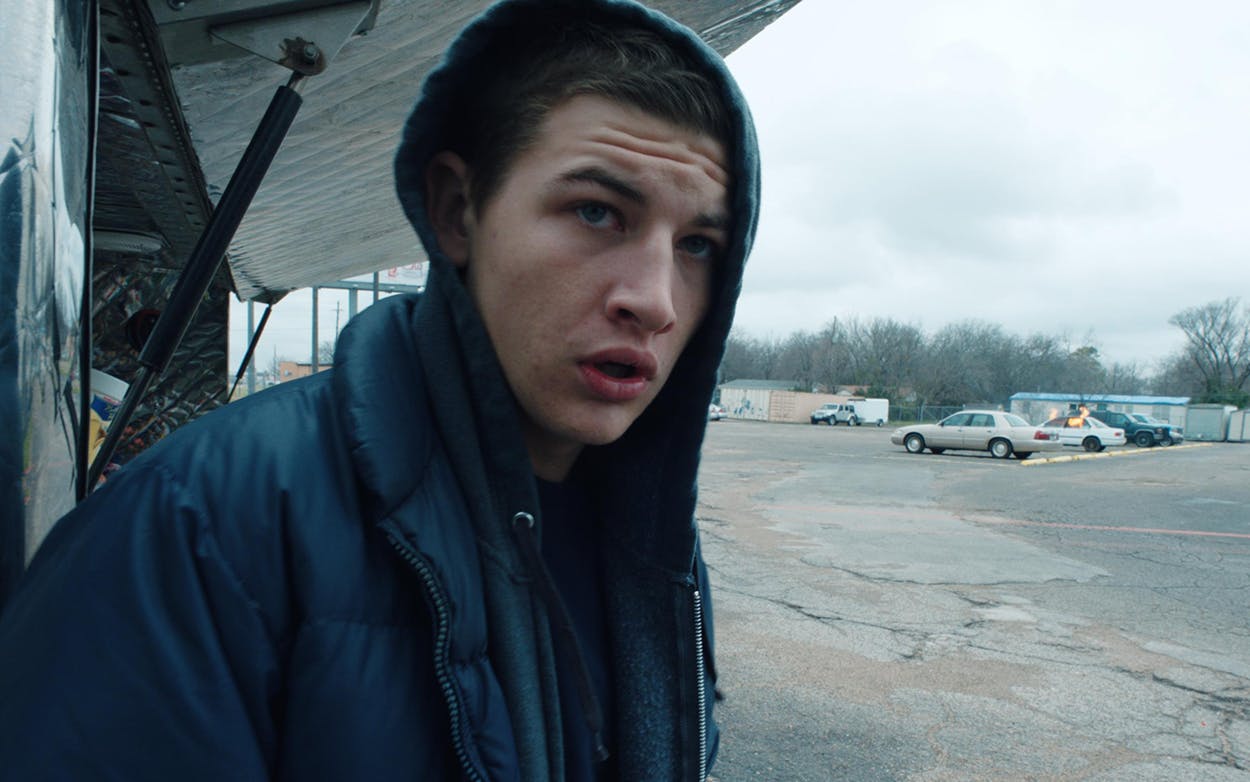Sunday night, little more than an hour and a half before the world premiere of the hundred-million-dollar Steven Spielberg movie he stars in, Elkhart native Tye Sheridan stood onstage at Austin’s State Theatre to enthusiastically introduce another feature, one that won’t break box office records or land him magazine covers anytime soon. The film was Friday’s Child, a locally shot indie he made with writer, director, and Terrence Malick protégé A.J. Edwards. Edwards and Sheridan first met years ago, when Sheridan was ten and Edwards worked in the crew on The Tree of Life, Sheridan’s debut film. “We’ve come full circle,” the soon-to-be-superstar East Texan told the audience, before sincerely thanking all in attendance, as well as the entire cast and crew, and heading next door to hang out with a thousand or so fans and a guy he probably calls “Steven.”
The earnest charm Sheridan displayed onstage turned out to emotionally anchor all 91 minutes of the movie that followed his introduction. A liberal retelling of Fyodor Dostoyevsky’s Crime and Punishment, Friday’s Child is a study of the circumstances that lead individuals to commit unforgivable acts and those that lead others to forgive. Sheridan stars as Richie, a young man newly aged out of the Killeen foster system that raised him. He struggles at self-sufficiency and turns to petty crime out of desperation. There are violent consequences. But even as the audience witnesses young Richie’s morale decline, he is never not forgivable. Sheridan’s tenderhearted performance makes forgiveness an inevitability.
Friday’s Child is Edward’s second film, and it’s what you would expect from someone IndieWire once referred to as a “Terrence Malick disciple.” Light on plot, heavy on lens flare, Friday’s Child is quiet and beautifully shot. The audience is engaged not so much by what happens but by what is shown. Early in the film, one of Richie’s social workers describes the aging-out process as an “emancipation,” but cinematographer Jeff Bierman’s often claustrophobic camerawork makes almost nothing about Friday’s Child feel free. The audience first picks up on the pressure that Richie is under visually, and then a handful of patched-together scenes (a docked paycheck, a phone call with the water company about an unpaid bill) provide context for the tone.
If the aim of a visual storyteller is for the images to resonate with audiences, for pictures to inspire emotions, then Friday’s Child is in many ways successful. A number of shots stay with you: the sun reflecting off near-frozen dew on a patch of St. Augustine grass, a bright-white Christmas tree casting shadows across a midcentury-modern living room, the spooky glow of Dan Flavin’s fluorescents at the Chinati Foundation. I was captivated by Joan’s (Imogen Poot) heavy, grief-stricken visage and the way a perennially intoxicated Swim (Caleb Landry Jones, perhaps better known as the drummer from Crucifictorious) struggled to put one foot in front of the other and walk in a straight line. But I was likely most taken in by Tye Sheridan’s sweet furrowed brow and the intensity with which he buried his hands in his coat pockets. The emotional stakes of the movie rest upon Richie’s slumped, burdened shoulders, a sight that inspires the audience to sympathize with, and even root for, the film’s main character.
And yet, with so little dialogue and even less exposition, the film ultimately does its story a disservice. If we only learn about characters through visual clues and a hodgepodge of throwaway lines, how are we to understand their motivations? The performances in Friday’s Child are commendable (with the exception of Jeffrey Wright, who is usually fantastic, but just not convincing as a McLennan County detective), but few of the characters’ choices and actions carry much weight in the absence of actual backstory. There were also several scenes in the film when narrative coherence seemed completely sacrificed for the sake of a pretty set piece, like when Joan’s Waco-based employer hosts a glamorous New Year’s Eve party in an ornate, 19th-century-era salon, which absolutely drove me nuts.
No matter their narrative value, all of the film’s scenes are beautiful, and Edwards has successfully recreated the breathtaking union of light, shadow, and space that we’ve come to rely on from his mentor. Friday’s Child is a feast for the eyes, and viewers familiar with Waco, Austin, and West Texas, where the film was shot, will be especially satiated. But if you want your movies to offer more than a coffee table book of beautiful photographs does, Friday’s Child may leave you frustrated.
After the screening, Edwards was asked what he hoped audiences would take away from the film. He responded that “the film was conceived as a story exploring forgiveness in impossible circumstances, forgiving the unforgivable, and how that’s expected of all of us.” But if you want the audience to walk away feeling like they’ve seen “all of us” onscreen, then you have to present them with relatable characters—which requires a little more plot and a little less lens flare.








